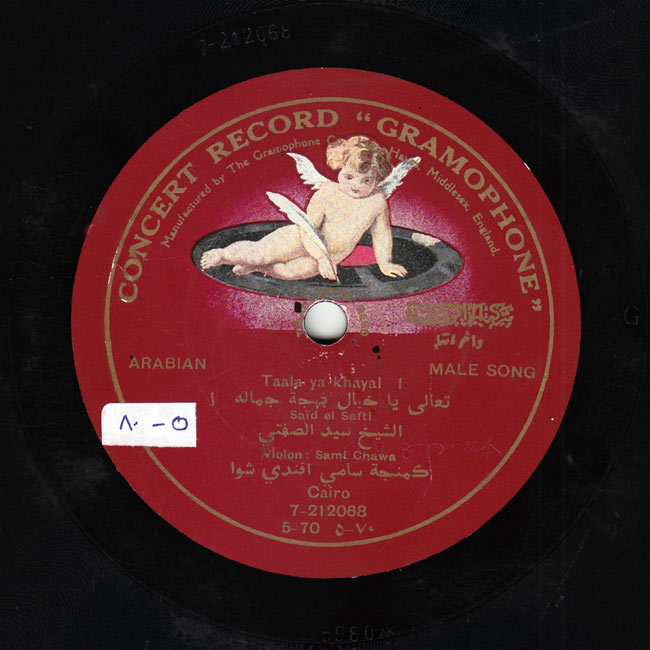Images
All images are courtesy of AMAR Foundation

search

All images are courtesy of AMAR Foundation

The taqsīm (3)
The Arab Music Archiving and Research foundation (AMAR), in collaboration with the Sharjah Art Foundation (SAF), presents Niẓāmunā al-Mūsīqī.
Dear listeners,
Welcome to a new episode of Niẓāmunā al-Mūsīqī.
Today, we will resume our discussion about the taqsīm.
Concerning the rhythm:
As mentioned earlier, the taqsīm is initially structured upon the measure of the melodic phrase, i.e. the trochee of the lyrics, in the Arabic language for example. But, like the qaṣīda ‘ala al-waḥda, the improvised taqsīm phrase was scanned according to a cyclic rhythm. Yet, the taqsīm remains luckier than the qaṣīda ‘ala al-waḥda since, unfortunately, there are only a few samples left of qaṣīda improvised to non-binary rhythms, the large majority of recordings are of qaṣīda ‘ala al-waḥda improvised to binary rhythms, such as the major beat, the medium beat, or fast beat… that is apart from the rhythms’ appellations.
Most taqsīm that have reached us are to the major beat known as the bamb, i.e. the same latent rhythm to which the qaṣīda’s lāzimat al-‘awādhil (āh yā anā) is improvised, particularly in the case of the baḥr ṭawīl (fa‘ūlun mafā‘īlun), which makes it easier to scan its extension onto the accentuation of this melody.
To illustrate this, let us listen to part of qaṣīda Arāka ‘aṣiyy al-dam‘i in the voice of ‘Abd al-Ḥayy Ḥilmī, followed by its instrumental interpretation by Muṣṭafa Sayyid Aḥmad al-Rashīdī and the Mazāmīr band.
(♩)
Such a supposition, added to the lack of taqsīm to this rhythmic beat in any other tradition, lead to another hypothesis: that the taqsīm ‘ala al-bamb specifically, is a result of the Arab music innovation movement started by ‘Abduh al-Ḥāmūlī and Muḥammad ‘Uthmān.
Also, the taqsīm ‘ala al-bamb seems to have started as a transitional section or as a conclusion to the waṣla with the taqsīm layālī ‘ala al-bamb. This section includes a dialogue between the vocalist, the instrumentalist, and a third performer at least, if not a few other performers abiding by what is known as the zanna, or the waḥda tune, i.e. a melodic structure where the instrument interprets the dum and tak of the rhythm.
As an example, let us listen to layālī ‘ala al-waḥda performed by Sheikh Sayyid al-Ṣaftī, Sāmī al-Shawwā, ‘Abd al-Ḥamīd al-Quḍḍābī, Ibrāhīm al-Qabbānī, and Maḥmūd Raḥmī, recorded around 1918 by Gramophone on one side of a 25cm record, # 7-212069, matrix # 5981 ak.
(♩)
The above easily leads to deducing the latent ‘arūḍ in Sheikh Sayyid’s layālī as well as in the instrumental interpretation, as made very clear in the instrumental taqsīm.
Muḥammad al-‘Aqqād’s instrumental performance defines him as one of those best versed in language: listeners can truly feel the words within his taqsīm to the rhythm. It seems that he made up for the maqām’s modulation and variation with his precise segmentation and the scansion of the rhythm.
Let us listen to his qānūn performance to the ṣabā of a taqsīm ‘ala al-waḥda, bamb beat, recorded around 1921 by His Master’s Voice — daughter company of Gramophone — on two sides of a 25cm record, # 7-218011 and 7-218012, matrix # BD 1691 and BD 1692, accompanied by Sāmī al-Shawwā (kamān) and Maḥmūd Raḥmī (percussions).
(♩)
Apart from the rhythmic beat, the taqsīm ‘ala al-waḥda highlights some unique talents, notably the possibility to go outside the melodic qisma (scansion) by playing the rhythms equally, then bringing back the qisma to the rhythm.
We have heard this in Al-‘Aqqād’s taqsīm, while the most famous for it is Sāmī al-Shawwā, who is the performer of the following kamān taqsīm rāst to the bamb, recorded around 1919 by Gramophone on one side of a 25cm record, # 7-217902, matrix # 6297 ak, accompanied by ‘Abd al-Ḥamīd al-Quḍḍābī (qānūn), Ibrāhīm al-Qabbānī (‘ūd), and Maḥmūd Raḥmī (percussions).
(♩)
Dear listeners, we have reached the end of today’s episode of Niẓāmunā al-Mūsīqī.
We will meet again in a new episode to discuss the different types of taqsīm.
Niẓāmunā al-Mūsīqī is brought to you by Mustafa Said.